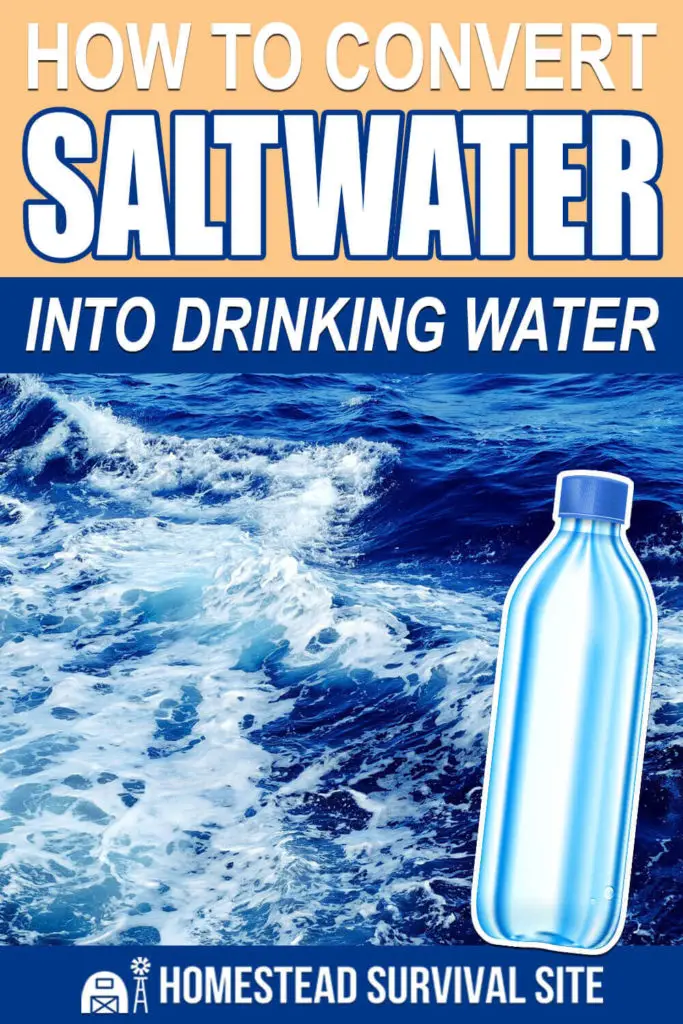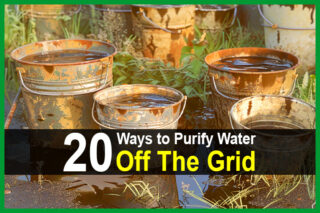Estimated reading time: 5 minutes
The absence of water makes any survival situation difficult, but any lack of drinking water turns any situation into a deadly one. While many of us have gallons upon gallons of freshwater stored in our homes, it is also a good idea to learn how to turn other water sources into fresh drinking water that is safe to consume.
A whopping 96.5% of the water on our planet is saltwater with the rest being freshwater. Just that statistic alone should propel everyone to learn how to turn saltwater into drinking water. The process of turning salt water into drinking water is called desalination.
The main issue with turning salt water into drinking water is the overall salt content. While the body does need salt to function properly, the sheer amount of salt in saltwater quickly dehydrates the body. Keep reading to learn the different techniques on how to turn salt water into drinking water.
Want to save this post for later? Click Here to Pin It On Pinterest!
Thermal Distillation
There are two main ways to turn saltwater into drinking water. One of them is thermal distillation, which requires a heat source like the sun or a fire to help purify the water through evaporation.
Simple Distillation
When using the simple distillation method, a container of saltwater is heated up to the boiling point. The water vapor escapes while the salt is left behind. The water vapor is then collected in another connected container. The water vapor cools to become a freshwater liquid while the salt is left behind in the heated container.
There are different ways to perform simple distillation, and it is a great method to know in a survival situation. Glass bottles are often used for this method as they can be found washed up on the shore of the saltwater source.
Sand is also a primary part of this process as sand is widespread along the beach as well. Sand also helps protect the glass from shattering and heats the glass evenly. Add in a heat source, like a rocket stove, and you can easily set up a simple distillation to create drinkable water.
The downside to this method is that you are limited to the amount of water that can fit within the glass bottles themselves. It would require many batches to create enough drinking water if the containers used are small.
Solar Still
Another way to turn saltwater into drinking water is to consider building your own solar still. You can purchase solar stills online as well, but understanding how they work and how to make one can save your life in an emergency situation.
Solar stills use the power of the sun and evaporation to provide fresh water. They also are a vital skill to have if you ever find yourself in the desert without a water source.
How to build a solar still:
- Dig a hole in the ground and place a bowl, cup, or some kind of clean basin in the center of the hole.
- Add saltwater to the bottom of the hole, as well as any other vegetation you can find. Although small, the water content of the vegetation can help create more drinking water.
- Cover the hole with a piece of plastic sheeting that won’t soak up moisture.
- Place large stones or weight on the edges of the sheeting so that it stays securely in place and seals off the edges. It is vital to ensure that the sides of the sheeting are airtight to keep all of the warm air inside the hole.
- Place a rock or weight on top of the middle of the sheet so that the weight sits directly above the cup underneath.
And that's it! The sheeting and the sun create a sauna for the hole, and water within the surrounding soil or sand will evaporate and collect on the underside of the sheeting. The weight in the middle of the sheet will create an angle where the water droplets will roll down and drop into the cup.
The amount of water collected will depend on the amount of water in the hole, soil, and the heat of the day.
Membrane Separation
The other common way to turn saltwater into drinking water is called membrane separation. This style of purification runs saltwater through material that helps remove the salt particles from the water.
Reverse Osmosis
You can also use reverse osmosis to purify salt water into potable drinking water. However, reverse osmosis requires special equipment that would be difficult to come by in a survival situation. If you do have the means to build your own reverse osmosis system, you could use it to turn gallons of saltwater into drinking water. Many smaller versions are available for home use as well.
Filter Through Fabric
Most experts don’t think that filtering saltwater through fabric removes enough salt particles. However, people have survived emergencies using the shirt off their back to help filter saltwater.
Studies have also shown that it is possible to filter out contaminants using ordinary clothing as filters. The good thing about this tactic is that you would immediately tell if the filter worked or not by tasting the saltiness of the filtered water. This is a last-ditch option for those in a survival situation.
It is essential to understand how to turn saltwater into drinking water no matter where you live. Freshwater isn’t guaranteed, and knowing how to keep yourself and your family hydrated can be the difference between life and death.
A solar still is the best option in a survival situation as you rely on the sun as the heat source instead of fire and wood. Keep all of this information in mind if you ever need it for future use. You’ll be glad you did!
Like this post? Don't Forget to Pin It On Pinterest!











Coffee filters make good filtering devices. That is their design purpose and a whole raft of coffee filters takes up little space and weighs not very much. I like #4 cone filters for my bug out bag but basket filters have also worked very well around the house when filtering lumps form paint or other chemicals that have developed some kind of funk but still appear otherwise serviceable.Always bear in find coffee filters only filter out junk. They do nothing about microscopic bad wigglies. Those have to be treated by boiling or chemical warfare or the SOLDIS method which works well in the desert if you can find the water to begin with. Look for greenery in the desert and dig in the sane at the foot of the greenery to find water. Even if it is grasslands and not old fashioned cactus growing desert, look for a stand of trees or large bushes. Dig at the roots. Sometimes you have to go down pretty far but if there are trees and large bushes, you can bet the farm if you dig deep enough you will find a good source of water.
f you read the literature carefully about solar distillation, the old bag on a bunch of leaves or hole in the ground with a plastic cover, even the most ideal conditions don’t yield more than a pint of water per day which is way below what one needs to maintain life. It is my opinion, that spending a day squatting beside a solar still is a monumental waste of time and in addition, is dangerous to life. Sure, if you can find shade, sit beside a solar still but be prepared to move out as soon as the sun hits the horizon. I believe in an end of the world situation, you are better off moving as long as you can than you are sitting beside a solar still hoping that it will produce the quantity of water you need to survive.